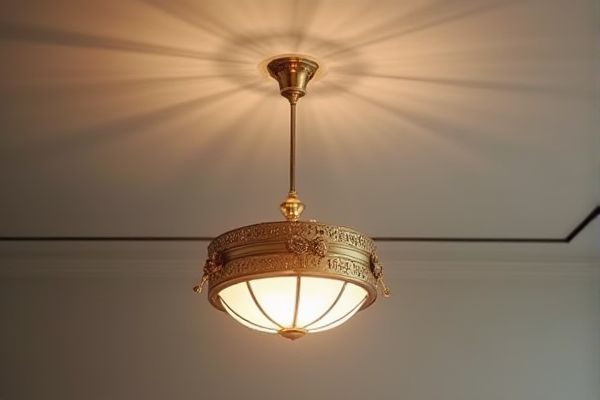
Pendant lights create a focal point with their hanging design, ideal for adding style and targeted illumination in dining areas or kitchens. Flush mount fixtures sit close to the ceiling, offering a sleek, space-saving option perfect for rooms with low ceilings or where subtle lighting is preferred; explore the rest of the article to determine which lighting fits your space best.
Table of Comparison
| Feature | Pendant Light | Flush Mount |
|---|---|---|
| Design | Hangs from ceiling, adjustable length | Mounted directly on ceiling, close to surface |
| Room Size | Best for medium to large rooms | Ideal for small to medium rooms |
| Ceiling Height | Works well with high ceilings | Suitable for low ceilings |
| Light Distribution | Focused, directional lighting | Even, ambient lighting |
| Installation | Requires hanging hardware and wiring | Simple mounting, fewer components |
| Style | Varied styles, decorative statement | Minimalistic, functional |
| Maintenance | Easier to clean, but can collect dust | Compact and easy to maintain |
| Cost | Typically higher price range | Generally affordable |
Introduction: Pendant Light vs Flush Mount
Pendant lights provide focused illumination and serve as stylish focal points, ideal for dining areas and kitchens with higher ceilings. Flush mount fixtures offer a compact, space-saving design that delivers even ambient lighting, perfect for rooms with low ceilings or limited space. Both lighting options enhance interior aesthetics and functionality depending on room height and design preferences.
Key Differences Between Pendant and Flush Mount Lights
Pendant lights hang from the ceiling with a visible cord or chain, creating a focal point and adding decorative appeal, while flush mount lights are fixed directly against the ceiling, offering a sleek and unobtrusive look. Pendant lights provide directional lighting ideal for task areas like kitchen islands, whereas flush mounts deliver more diffuse, ambient light suitable for low-ceiling rooms. Your choice depends on ceiling height, room function, and desired aesthetic impact.
Design and Aesthetic Appeal
Pendant lights offer a striking focal point with their varied shapes, sizes, and materials, adding depth and visual interest to a room's design. Flush mount fixtures provide a sleek and minimalist aesthetic, seamlessly blending with ceilings to create a clean, unobtrusive look ideal for low ceilings or subtle lighting needs. Your choice between pendant and flush mount lighting will significantly impact the ambiance and style of your space, balancing bold statement pieces against understated elegance.
Space and Ceiling Height Considerations
Pendant lights are ideal for rooms with high ceilings where they can serve as focal points without obstructing movement, offering adjustable hanging lengths to suit various heights. Flush mount lights work best in spaces with low ceilings, providing unobtrusive, evenly distributed illumination while maximizing headroom. Your choice between pendant and flush mount lighting should consider ceiling height and room size to ensure optimal lighting and spatial harmony.
Lighting Performance and Distribution
Pendant lights offer focused, directional illumination ideal for task lighting over dining areas or kitchen islands, creating targeted brightness with minimal glare. Flush mount fixtures provide even, ambient light distribution suitable for general room lighting, ensuring a uniform spread across ceilings and walls. The choice impacts lighting performance by balancing focused versus diffused light based on room size and functional needs.
Installation Process and Maintenance
Pendant lights require installing a secure ceiling hook or bracket and often involve wiring adjustments, making the process more complex compared to flush mount fixtures that attach directly to the ceiling surface. Maintenance for pendant lights includes regularly cleaning the exposed bulb and shade, which can be easier than accessing flush mounts that may require removing the entire fixture for bulb replacement. Your choice depends on comfort with electrical work and ongoing ease of upkeep.
Energy Efficiency and Bulb Compatibility
Pendant lights often accommodate a wider variety of bulb types, including LED, CFL, and incandescent, allowing for greater energy efficiency customization compared to flush mounts, which typically have limited bulb compatibility. LED bulbs used in both pendant and flush mount fixtures provide significant energy savings, with pendant lights offering more flexibility in wattage and style to optimize lighting needs. Choosing an energy-efficient LED bulb with compatible fixture design maximizes power savings while maintaining desired illumination in either pendant or flush mount installations.
Suitable Rooms for Pendant and Flush Mount Lights
Pendant lights are ideal for kitchens, dining rooms, and entryways where focused lighting and decorative appeal enhance ambiance and functionality. Flush mount lights suit bedrooms, hallways, and closets, offering low-profile illumination perfect for spaces with limited ceiling height. Your choice depends on room size, ceiling height, and the desired lighting effect to harmonize with your interior design.
Cost Comparison: Pendant vs Flush Mount
Pendant lights typically range from $50 to $300 depending on design complexity, while flush mounts generally cost between $40 and $200, making flush mounts more budget-friendly for basic lighting needs. Installation expenses for pendants can be higher due to ceiling height adjustments and wiring requirements, whereas flush mounts offer simpler, quicker setups that often reduce labor costs. Both lighting options vary widely in price based on materials, brand, and size, but flush mounts tend to provide more economical choices for straightforward lighting solutions.
Choosing the Right Fixture for Your Space
Pendant lights create a focal point and add vertical interest, ideal for spaces with higher ceilings or over dining tables and kitchen islands. Flush mount fixtures offer a sleek, low-profile design perfect for rooms with low ceilings or where unobtrusive lighting is desired. Consider your room's height, style, and lighting needs to choose the fixture that enhances both function and aesthetics.
 homyna.com
homyna.com